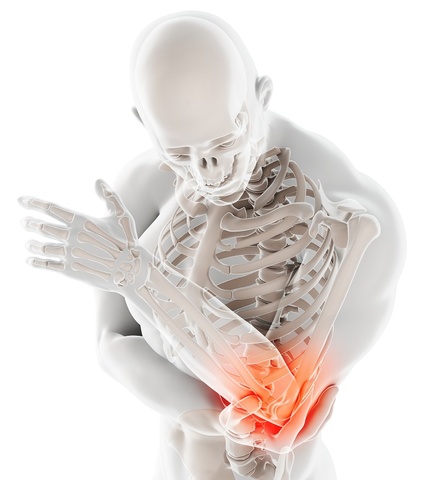
FAST FACTS: Joint Pain

Joint pain is associated with either a trauma to or disease of the joints and is extremely common in older adults. If there has not been a traumatic injury, such as a fall, the focus of joint pain is on an inflammatory joint disease such as chronic osteoarthritis, degenerative joint disease, or gouty arthritis. Both OA and DJD have a slow onset and become a chronic condition. Both may respond to pain medications or physical therapy. Gout requires prescription medication during the acute attack.
Osteoarthritis (OA) / Degenerative Joint Disease (DJD)
- Common sites are knees, fingers, ankles, spine, hips, feet, shoulder
- Affects multiple sites and is caused by wear and tear on the joint
- Signs/symptoms: joint stiffness is most common in morning, pain typical after exercise or pressure on joint, rest may not relieve pain in the affected joint
Gouty Arthritis
- Most common site is the big toe, followed by ankles, heel, knee, wrist, and fingers
- Seen in men over age 35 and woman after menopause
- Caused by increased levels of uric acid
- Signs/symptoms: red, hot, swollen, and/or inflamed joint but NO morning stiffness
Traumatic Injury
- Dislocation or ligament/tendon injury; sudden onset of pain/swelling after a trauma;
- Immobilize the injury site and call your loved one’s healthcare provider, ice may help
Possible Intervention(s)
- Osteoarthritis / Degenerative Joint Disease
- Try early morning range of motion or low impact exercise
- If pain is in response to exercise, rest the joint; ice or heat may also help
- Medication is often needed to relieve the pain
- Gouty Arthritis
- Medication typically needed at the onset of an attack
- Prevention is KEY: avoid alcohol and foods high in purines which are the chemical compounds that cause uric acid (get list from healthcare provider)
What Else You Should Do
- Write down and share information about your loved one’s pain with their healthcare provider
- Use a Pain Diary to note important information useful to the healthcare provider
- Encourage your loved one to try a non-drug treatment and document the impact on their pain in their Pain Diary
References:
- WebMD. June 15, 2021. Joint Pain. Accessed 3.13.2022. https://www.webmd.com/pain-management/guide/joint-pain
- Cleveland Clinic. March 28, 2018. Joint Pain. Accessed 3.13.2022. https://my.clevelandclinic.org/health/symptoms/17752-joint-pain
- Centers for Disease Control and Prevention (CDC). December 2, 2021. Joint Pain and Arthritis. Accessed 3.13.2022. https://www.cdc.gov/arthritis/pain/index.htm
Revised January 2022
